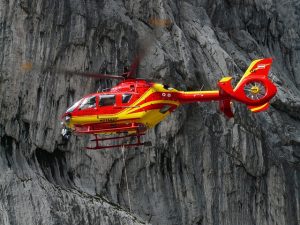
Wire strikes are a concern for helicopters. According to the U.S. Federal Aviation Administration (FAA), they account for nearly 6% of all single-turbine helicopter accidents and a little over 4% of all twin-turbine helicopter accidents.
Wire strikes often involve power lines. Most overhead power lines are about 50 to 200 feet above ground. Helicopters typically fly at a higher altitude, but they may still fall within this range when taking off or landing. Fortunately, there are safeguards available to protect helicopters from wire strikes.
Wire Detection Systems
Many helicopters are equipped with a wire detection system. As the name suggests, this system is designed to detect the presence of wires near the helicopter. Some of them use lasers, whereas others use forward-looking infrared (FLIR) cameras. Regardless, wire detection systems are able to detect the presence of nearby wires. They will alert the pilot about nearby wires, at which point the pilot can take evasive action.
Pilot Training
Something as simple as pilot training can protect helicopters from wire strikes. Private helicopter pilots in the United States go through about two to four months of formal training. During this training, they learn about the dangers of wires and how to avoid them.
Communications
Communications can protect helicopters from wire strikes. Pilots should communicate with other pilots in the area, as well as with air traffic controllers, to identify potential hazards like wires.
Wire Cutters
Wire cutters are mechanical devices that are designed to cut wires. They’ve been around for decades, with some of the earliest helicopter-fitted wire cables being released in the late 1970s. Since then, wire cutters have become an integral safety component of many helicopters.
What are wire cutters exactly? They consist of a bladed edge found on the front of a helicopter. They won’t necessarily prevent helicopters from making contact with wires. Rather, wire cutters are designed to cut the wires if contact occurs.
Some wire cutters are installed directly above the cockpit, whereas others are installed below the cockpit. Regardless, they are all sharp, bladed wedges that can cut through wires.
In Conclusion
Wires pose a safety hazard to helicopters. As revealed by the FAA, wire strikes are one of the leading causes of helicopter accidents. But there are ways to protect helicopters from wire strikes, such as wire detection systems, pilot training, communications and wire cutters.



